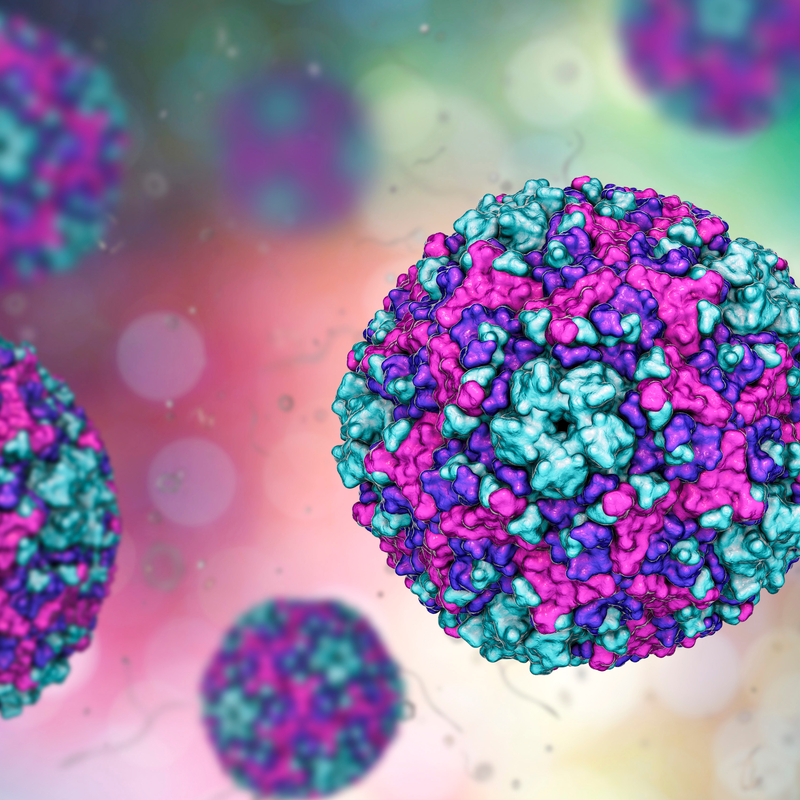
What is a Coxsackie B5?
The Coxsackie B5 virus belongs to the family of single-stranded RNA viruses and to the Picornaviruses. The hepatitis A virus also belongs to this family . The Coxsackie B5 viruses are found all over the world, but are particularly widespread in Central Europe, where a mild climate prevails. Most infections with the virus are recorded especially in summer and late summer . Often, there can also be an epidemic outbreak during these times. They are often the cause of various severe systemic diseases .
What is the morphology of Coxsackie B5 viruses?
The viruses are between 20 and 40 mm in size and have a single-stranded RNA that is positively polarised. Coxsackie B5 viruses do not have a viral envelope, the genome is enveloped in a cubic capsid . They have a high survival rate and enormous stability in acidic environments. They are highly sensitive to chlorine-containing disinfectants , which is why Coxsackie B5 viruses cannot be combated with conventional disinfectants based on detergents and alcohol. At room temperature, Coxsackie B5 viruses can be superior for days and also contagious.
How are Coxsackie B5 viruses transmitted?
The Coxsackie B5 viruses are predominantly transmitted via the human-to-human fecal-oral route. However, droplet infections and smear infections are also possible transmission routes. After ingestion via the oral route, the viruses first multiply in the pharyngeal mucosa and then in the intestinal wall. The Coxsackie B5 viruses are mainly excreted from the body via the stool.
What are the symptoms of the Coxsackie B5 virus?
In most cases, an infection with the Coxsackie B5 viruses runs without symptoms or with only a few complaints. After the incubation period of about 6 days, patients experience fever, general malaise and headache. In many cases, flu-like symptoms such as rhinitis, nausea, vomiting and pharyngitis also occur. Another accompanying symptom may be mild gastroenteritis. Usually the symptoms subside after about 3-4 days, but rarely last longer than a week.
Coxsackie B5 viruses are also mainly responsible for the following diseases:
- aseptic meningitis,
- Encephalitis,
- Paralysis,
- Exanthema
- Generalised disease in the newborn,
- Hand-foot-and-mouth disease,
- Herpangina,
- Pericarditis, myocarditis,
- Pneumonia,
- Pleurodynia.
Pleurodynia
Pleurodynia is also known as epidemic myalgia or as Bornholm disease and is noticeable by acutely rising fever, cramping and stabbing pain in the chest. Especially in affected children, upper abdominal pain may present as complaints. Such attacks usually last about 15 to 30 minutes and are accompanied by tachypnoea and sweating. About an hour after the onset of the attack, the fever is highest at , and as the pain subsides, the temperature also drops again. The affected muscles are tender and pleural rubbing may be heard on auscultation. The attacks are mostly caused by Coxsackie B1-B5 viruses. Within a few days, the symptoms improve and a recurrence can almost be ruled out. Treatment is with non-steroidal anti-inflammatory drugs (NSAIDs) and other measures to relieve the symptoms such as heat treatment of the joking regions.
How are Coxsackie B5 viruses diagnosed?
Depending on the clinical picture, the type of diagnosis is chosen. In an acute phase, molecular biological detection in stool, pharyngeal lavage fluid or cerebrospinal fluid using a PCR test is an option. Serological tests are excellent for monitoring the rise in the titer, but not for making a reliable diagnosis .
How are Coxsackie B5 viruses treated?
The therapy for Coxsackie B5-triggered diseases is usually symptomatic with antipyretics and analgesics. If severe courses of the disease develop, gamma globulin preparations are used. In the case of a secondary bacterial infection, antibiotics are used. Antivirally effective drugs are currently still being tested. The drug interferon, which is mainly used for cardiomyopathies, has so far proven to be extremely effective .
How long is the Coxsackie B5 virus contagious?
A patient is considered to be particularly highly contagious during the first few weeks. After the symptoms have subsided, however, the viruses are still excreted in the stool for several weeks. This is why an affected person is considered to be infectious for a very long time. Even after all symptoms have disappeared, it is essential that hygiene rules continue to be observed, in order to avoid transmission of the viruses.
What is the prognosis for Coxsackie B5 virus?
The patients usually recover very well from the disease. This is also due to the fact that it is usually mild and symptomatic treatment is completely sufficient. Nevertheless, complications such as myocarditis, pericarditis, meningoencephalitis and meningitis must be expected at any time.
How can the Coxsackie B5 virus be prevented?
The following measures are important and must be observed in order to prevent infection with the Coxsackie B5 virus:
- Especially on the neonatal ward, proper hospital hygiene should be observed, which means using antiviral disinfectants with chlorine, changing doctors' and nurses' gowns regularly and, if necessary, isolating infected newborns .
- Exposure prophylaxis, i.e. adequate hand hygiene, first washing hands with soap and water, then disinfecting.
- Post-exposure prophylaxis, which means that gamma globulins are given within 3 days if there is a high risk.
Sporadic
Detections of Coxsackie B5 viruses do not have to be reported according to the Infection Protection Act
. However, if the outbreaks become more frequent,
a report by the laboratory director must be issued to the public health department. A
patient who has survived an infection is immune to
the virus for life. There is currently no vaccination against Coxsackie B5 viruses
.
